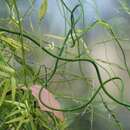en
names in breadcrumbs


Geitonoplesium is a monotypic genus in the family Asphodelaceae, containing the sole species Geitonoplesium cymosum, commonly known as scrambling lily.[5][6] The species is a perennial evergreen scrambling vine found in rainforests, sclerophyll forests and woodlands of eastern Australia,[5] and parts of Malesia and Melanesia.[2][6][7]
The leaves are variable, usually narrow-lanceolate to linear, 2–10 cm (0.8–3.9 in) long and 3–25 mm (0.1–1.0 in) wide. Both surfaces of the leaves are glossy, with the midvein prominent and raised on upper surface. The flowers are mauve to white. The globular berries are 5–11 mm (0.2–0.4 in) in diameter and contain one or two more or less globular black seeds.[5][6] There is a high degree of variation in the shape of the leaves, which has resulted in the establishment of numerous infraspecific taxa over the years, however none of these are recognised by leading present-day authorities.[8]
The shoots are edible when boiled, and comparable to asparagus.[9][10]
Geitonoplesium is a monotypic genus in the family Asphodelaceae, containing the sole species Geitonoplesium cymosum, commonly known as scrambling lily. The species is a perennial evergreen scrambling vine found in rainforests, sclerophyll forests and woodlands of eastern Australia, and parts of Malesia and Melanesia.
The leaves are variable, usually narrow-lanceolate to linear, 2–10 cm (0.8–3.9 in) long and 3–25 mm (0.1–1.0 in) wide. Both surfaces of the leaves are glossy, with the midvein prominent and raised on upper surface. The flowers are mauve to white. The globular berries are 5–11 mm (0.2–0.4 in) in diameter and contain one or two more or less globular black seeds. There is a high degree of variation in the shape of the leaves, which has resulted in the establishment of numerous infraspecific taxa over the years, however none of these are recognised by leading present-day authorities.